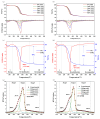Analysis of the Pyrolysis Kinetics, Reaction Mechanisms, and By-Products of Rice Husk and Rice Straw via TG-FTIR and Py-GC/MS
- PMID: 39795069
- PMCID: PMC11721799
- DOI: 10.3390/molecules30010010
Analysis of the Pyrolysis Kinetics, Reaction Mechanisms, and By-Products of Rice Husk and Rice Straw via TG-FTIR and Py-GC/MS
Abstract
This study employed thermogravimetric analysis (TGA), Fourier transform infrared spectroscopy (FTIR), and pyrolysis gas chromatography/mass spectrometry (Py-GC/MS) to characterize and provide insights into the pyrolysis behaviors and by-products of rice husk (RH) and rice straw (RS). The primary pyrolysis range is partitioned into three stages, designated as pseudo-hemicellulose, pseudo-cellulose, and pseudo-lignin pyrolysis, by an asymmetric bi-Gaussian function. The average activation energies of the three pseudo-components of RH were estimated by the Flynn-Wall-Ozawa and Starink methods to be 179.1 kJ/mol, 187.4 kJ/mol, and 239.3 kJ/mol, respectively. The corresponding values for RS were 171.8 kJ/mol, 185.8 kJ/mol, and 203.2 kJ/mol. The results of the model-fitting method indicated that the diffusion model is the most appropriate for describing the pseudo-hemicellulose reaction. The reaction of pseudo-cellulose and pseudo-lignin is most accurately described by a nucleation mechanism. An accelerated heating rate resulted in enhanced pyrolysis performance, with RS exhibiting superior performance to that of RH. RH produces 107 condensable pyrolysis by-products, with ketones, acids, and phenols representing the largest proportion; RS produces 135 species, with ketones, phenols, and alcohols as the main condensable by-products. These high-value added by-products have the potential to be utilized in a variety of applications within the agricultural, bioenergy, and chemical industries.
Keywords: Py-GC/MS; TG-FTIR; kinetics; master plot method; pyrolysis; rice residues.
Conflict of interest statement
The authors declare no conflict of interest.
Figures









References
-
- World Energy Outlook 2023. IEA; Paris, France: 2023. [(accessed on 11 March 2024)]. Available online: https://www.iea.org/reports/world-energy-outlook-2023.
-
- Mujtaba M., Fernandes Fraceto L., Fazeli M., Mukherjee S., Savassa S.M., Araujo de Medeiros G., do Espírito Santo Pereira A., Mancini S.D., Lipponen J., Vilaplana F. Lignocellulosic Biomass from Agricultural Waste to the Circular Economy: A Review with Focus on Biofuels, Biocomposites and Bioplastics. J. Clean. Prod. 2023;402:136815. doi: 10.1016/j.jclepro.2023.136815. - DOI
-
- Food and Agriculture Organization of the United Nations, FAOSTAT, Crops and Livestock Products. [(accessed on 4 March 2024)]. Available online: https://www.fao.org/faostat/en/#data/QCL.
Grants and funding
LinkOut - more resources
Full Text Sources
Miscellaneous

